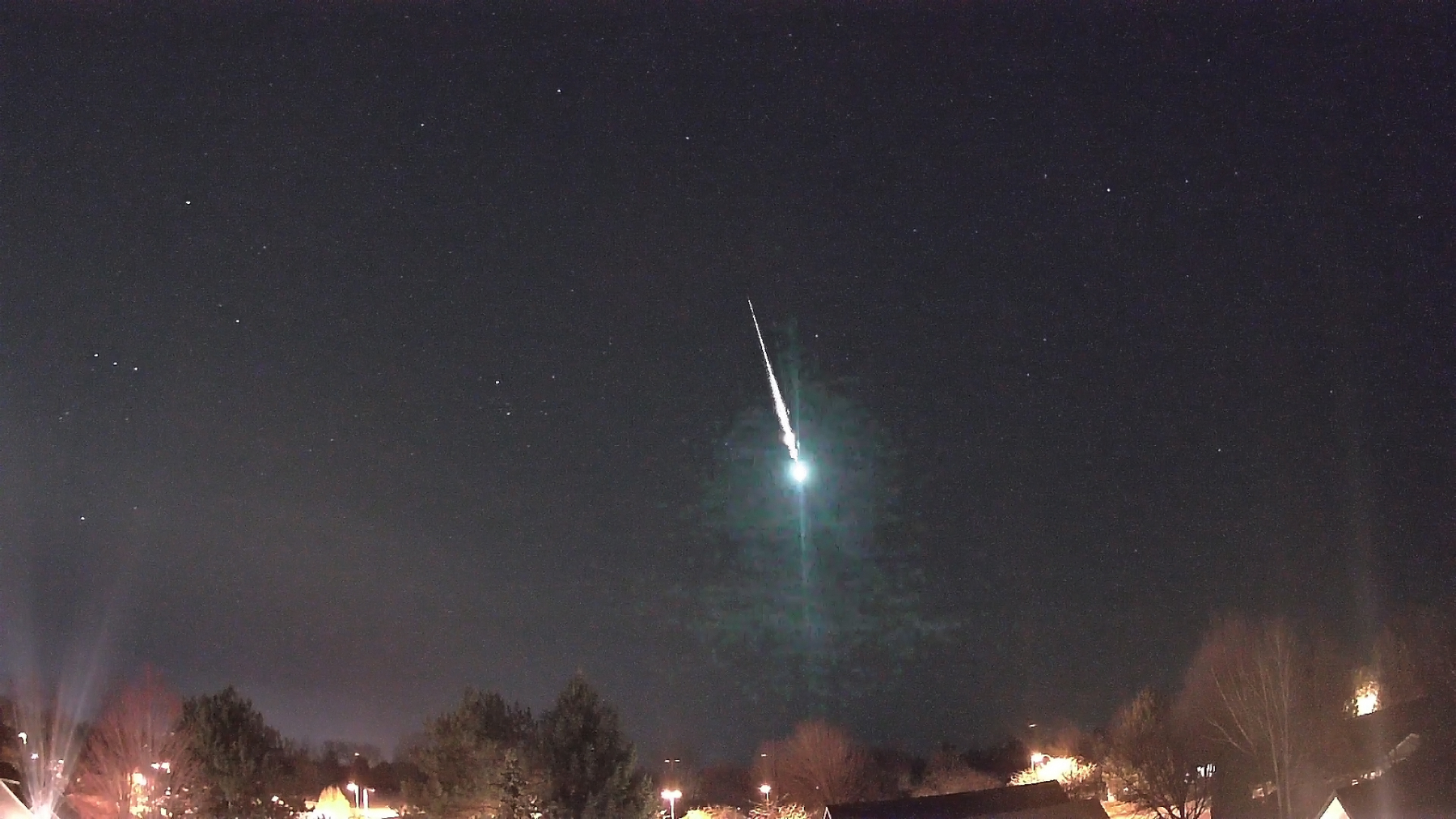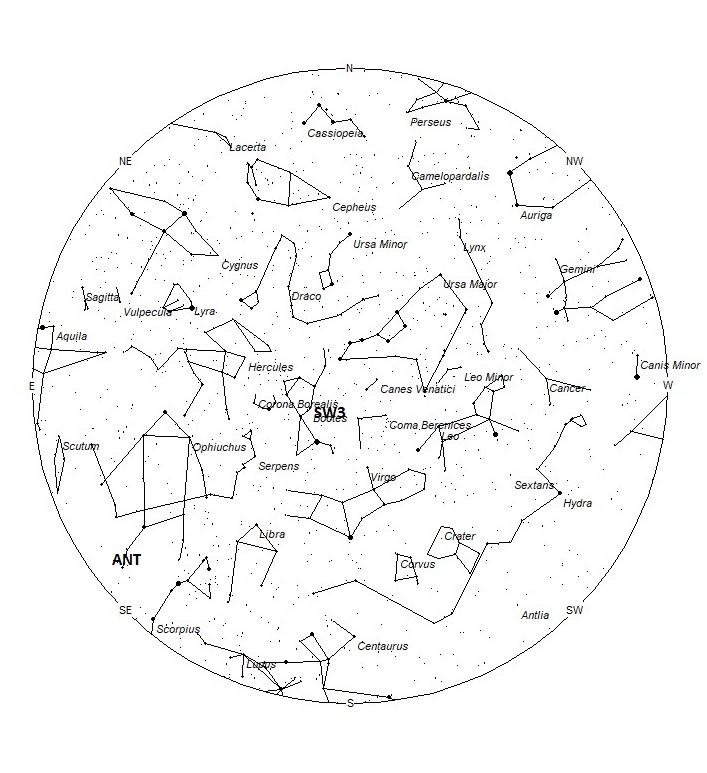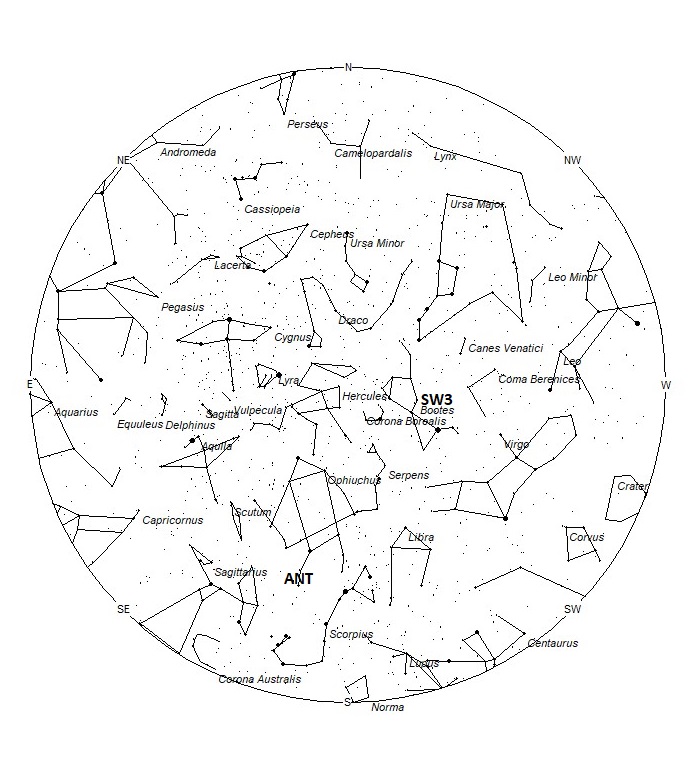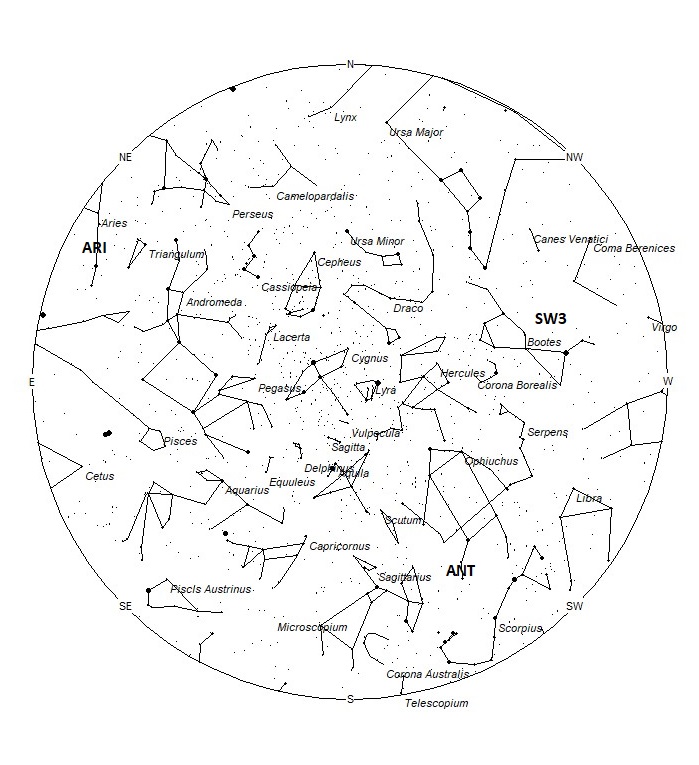 Jordan Ragsdale captured this brilliant fireball using his AllSky Camera System on March 29, 2022, at 22:52 MDT (4:52 UT on March 30th) from Eagle, Idaho, USA. ©Jordan Ragsdale
Jordan Ragsdale captured this brilliant fireball using his AllSky Camera System on March 29, 2022, at 22:52 MDT (4:52 UT on March 30th) from Eagle, Idaho, USA. ©Jordan RagsdaleAs seen from the Northern Hemisphere, June is another slow month for meteor activity. There are no major showers active in June and only the Anthelion source can be counted on for continuous activity. Sporadic rates continue to remain low as seen from the mid-northern hemisphere (45 N) with only half the rates seen from the mid-Southern Hemisphere. For the upper half of the Northern Hemisphere the nights are short to non-existent this time of year. As seen from the southern tropics (25 S) sporadic rates continue to be strong this month with morning hourly rates near 10.
During this period, the moon reaches its new phase on Monday May 30th. At that time the moon is located near the sun and is invisible at night. As the week progresses, the moon enters the evening sky but will set long before the more active morning hours arrive. For evening observers, the estimated total hourly rates should be near 3 as seen from mid-northern latitudes (45N) and 4 as seen from tropical southern locations (25S) For morning observers, the estimated total hourly rates should be near 5 as seen from mid-northern latitudes (45N) and 10 as seen from tropical southern locations (25S). The actual rates will also depend on factors such as personal light and motion perception, local weather conditions, alertness, and experience in watching meteor activity. Note that the hourly rates listed below are estimates as viewed from dark sky sites away from urban light sources. Observers viewing from urban areas will see less activity as only the brighter meteors will be visible from such locations.
The radiant (the area of the sky where meteors appear to shoot from) positions and rates listed below are exact for Saturday night/Sunday morning May 28/29. These positions do not change greatly day to day so the listed coordinates may be used during this entire period. Most star atlases (available at science stores and planetariums) will provide maps with grid lines of the celestial coordinates so that you may find out exactly where these positions are located in the sky. I have also included charts of the sky that display the radiant positions for evening, midnight, and morning. The center of each chart is the sky directly overhead at the appropriate hour. These charts are oriented for facing south but can be used for any direction by rotating the charts to the desired direction. A planisphere or computer planetarium program is also useful in showing the sky at any time of night on any date of the year. Activity from each radiant is best seen when it is positioned highest in the sky, either due north or south along the meridian, depending on your latitude. It must be remembered that meteor activity is rarely seen at the radiant position. Rather they shoot outwards from the radiant, so it is best to center your field of view so that the radiant lies at the edge and not the center. Viewing there will allow you to easily trace the path of each meteor back to the radiant (if it is a shower member) or in another direction if it is sporadic. Meteor activity is not seen from radiants that are located far below the horizon. The positions below are listed in a west to east manner in order of right ascension (celestial longitude). The positions listed first are located further west therefore are accessible earlier in the night while those listed further down the list rise later in the night.
These sources of meteoric activity are expected to be active this week.
.
Meteors from comet Schwassmann-Wachmann 3 (SW3) may be visible during this period, peaking on May 30th/31st. The radiant is expected to be located near 13:56 (209) +28. This area of the sky is located in western Bootes, near the faint star known as 9 Bootis. This location is also located 9 degrees northwest of the brilliant yellow-orange star known as Arcturus. This area of the sky is best placed near 2200 local summer time (LST) when it lies highest in the sky. While the predicted outburst occurs during daylight on May 31st for the Eastern Hemisphere, some activity may still be visible during the evening hours near this date. Those viewing viewing from the Western Hemisphere may see an impressive display near 05:00 Universal Time on May 31st or nothing at all. With an entry velocity of 16 km/sec., the average meteor from this source would be very slow. These meteors are also known as the tau Herculids (TAH).
The large Anthelion (ANT) is currently centered at 17:24 (261) -23. This position lies in southern Ophiuchus, 2 degrees south of the 3rd magnitude star known as theta Ophiuchi. Due to the large size of this radiant, these meteors may also be seen from western Serpens Cauda and western Sagittarius as well as southern Ophiuchus. This radiant is best placed near 02:00 LST when it lies on the meridian and is highest in the sky. Rates at this time should be near 2 per hour as seen from the Northern Hemisphere and 3 as seen from south of the equator. With an entry velocity of 30 km/sec., the average Anthelion meteor would be of slow velocity.
The Daytime Arietids (ARI) are active from May 29-June 17 with maximum activity occurring on June 4th. These meteors are difficult to catch as the radiant only lies 30 degrees west of the sun. Therefore, the only time these meteors are visible is during the last dark hour before dawn. The radiant is currently located at 02:28 (037) +23. This area of the sky is located in northwestern Aries, 4 degrees east of the 2nd magnitude star known as Hamal (alpha Arietis). Current rates are expected to be less than 1 no matter your location. With an entry velocity of 40 km/sec., the average meteor from this source would be of medium velocity.
As seen from the mid-northern hemisphere (45N) one would expect to see approximately 6 sporadic meteors per hour during the last hour before dawn as seen from rural observing sites. Evening rates would be near 2 per hour. As seen from the tropical southern latitudes (25S), morning rates would be near 10 per hour as seen from rural observing sites and 3 per hour during the evening hours. Locations between these two extremes would see activity between the listed figures.
You can keep track of the activity of these meteor showers as well as those beyond the limits of visual observing by visiting the NASA Meteor Shower Portal available at: https://meteorshowers.seti.org/ You can move the sky globe to see different areas of the sky. Colored dots indicate shower meteors while white dots indicate sporadic (random) activity. The large orange disk indicates the position of the sun so little activity will be seen in that area of the sky.
The list below offers the information from above in tabular form. Rates and positions are exact for Saturday night/Sunday morning except where noted in the shower descriptions.
| SHOWER | DATE OF MAXIMUM ACTIVITY | CELESTIAL POSITION | ENTRY VELOCITY | CULMINATION | HOURLY RATE | CLASS |
| RA (RA in Deg.) DEC | (Geocentric) Km/Sec | Local Daylight Saving Time | North-South | |||
| Schwassmann-Wachmann 3 (SW3) | May 31 | 13:56 (209) +28 | 16 | 22:00 | ? | III |
| Anthelions (ANT) | – | 17:24 (261) -23 | 30 | 02:00 | 2 – 3 | II |
| Daytime Arietids (ARI) | Jun 04 | 02:28 (037) +23 | 40 | 11:00 | <1 – <1 | IV |
 American Meteor Society
American Meteor Society



I seen a big green streak that was quite slow in maysville,Ky around 3:20. AWESOME